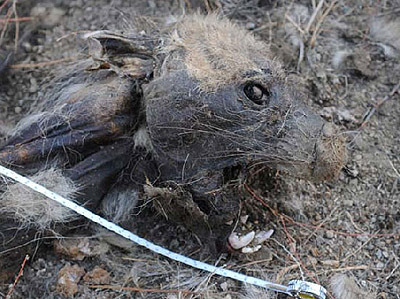WWF discovers Striped Hyaena in Armenia
Hyaena found for the first time after more than 60 years of disappearance
From ECOLUR - NEW INFORMATIONAL POLICY IN ECOLOGY
 In the morning of October 1, 2010, a dead Striped Hyaena (Hyaena hyaena) was found entangled on the orchard’s barbed-wire fence to the east of the Nrnadzor (formerly Nuvadi) village in the extreme south of Armenia by WWF wildlife expert A. Malkhasyan and WWF companion, Nrnadzor villager M. Boyajyan during their regular leopard (Panthera pardus) monitoring surveys. The body was obviously scavenged, but still remained fresh for unambiguous identification. The leftovers contained the head, scapula, pelvic bones, legs, and scattered pieces of brown-and-white striped fur. These materials were taken by A. Malkhasyan for further research and are now possessed by WWF Armenia.
In the morning of October 1, 2010, a dead Striped Hyaena (Hyaena hyaena) was found entangled on the orchard’s barbed-wire fence to the east of the Nrnadzor (formerly Nuvadi) village in the extreme south of Armenia by WWF wildlife expert A. Malkhasyan and WWF companion, Nrnadzor villager M. Boyajyan during their regular leopard (Panthera pardus) monitoring surveys. The body was obviously scavenged, but still remained fresh for unambiguous identification. The leftovers contained the head, scapula, pelvic bones, legs, and scattered pieces of brown-and-white striped fur. These materials were taken by A. Malkhasyan for further research and are now possessed by WWF Armenia.
This is the first ever reliable record of hyaena in Armenia since the late 1940s when, according to some anecdotal information, an individual was spotted in the western vicinities of Yerevan city. The published scientifically robust findings about hyaena occurrence in Armenia have been meager. According to some scientific sources, until the beginning of the 20th century, hyaenas used to be recorded occasionally along the Arax riverside in the country’s west (Echmiadzin district) and south (Meghri district), as well as in the north-east (Shamshadin and Ijevan districts). The last hyaena record in Armenia published in scientific literature dates back to 1925 and confined to the surroundings of the Novruzlu village, Artashat district, western Armenia. Habitat loss has been the principal cause of hyaena disappearance in Armenia. Suitable habitats (plain semi-deserts and arid foothills) are naturally limited to the Ararat Valley and a narrow strip of Arax lowlands in the Meghri district, which are almost completely cultivated for crop fields, orchards, and vineyards.
The striped hyaena is a medium-sized carnivore with overall appearance reminiscent of a dog. It has a back sloping downwards towards the tail, and black or brown vertical stripes on the sides. Its general colour is pale grey or beige. It has a black patch on the throat and black transverse and horizontal stripes on the fore and hind legs. The head is roundish with a pointed muzzle and long, pointed ears. Even though hyaena eats a diverse variety of foods like carrion, large and small animals, insects, fruits and berries, it has very strong jaws capable of crushing thick bones. Its preferred habitats are semi-deserts, dry hilly areas and riverine thickets up to 2100 m above sea level.
Inspired by this rediscovery, WWF strives to intensify its efforts on biodiversity monitoring, especially in Arevik National Park in the vicinity of which the dead hyaena was found and where more individuals might still be roaming around. WWF Armenia qualifies this scientific finding as an important precondition for further investigation of this species as well as outlines its upcoming work towards possible recovery of this species in the region.
Photo by A. Malkhasyan







